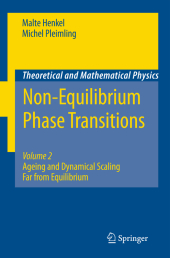 Neuerscheinungen 2014Stand: 2020-02-01 |
Schnellsuche
ISBN/Stichwort/Autor
|
Herderstraße 10
10625 Berlin
Tel.: 030 315 714 16
Fax 030 315 714 14
info@buchspektrum.de |

Malte Henkel, Michel Pleimling
(Beteiligte)
Non-Equilibrium Phase Transitions
Volume 2: Ageing and Dynamical Scaling Far from Equilibrium
2010. 2014. xxi, 544 S. 235 mm
Verlag/Jahr: SPRINGER NETHERLANDS 2014
ISBN: 9401783721 (9401783721)
Neue ISBN: 978-9401783729 (9789401783729)
Preis und Lieferzeit: Bitte klicken
Dynamical scaling is key to our understanding of ´far from equilibrium´ relaxation. Where Volume 1 of this set covered the statics and dynamics of transitions into an absorbing state, this one treats relaxation phenomena far from equilibrium and ageing.
"The importance of knowledge consists not only in its direct practical utility but also in the fact the it promotes a widely contemplative habit of mind; on this ground, utility is to be found in much of the knowledge that is nowadays labelled ´useless´. " Bertrand Russel, In Praise of Idleness, London (1935) "Why are scientists in so many cases so deeply interested in their work ? Is it merely because it is useful ? It is only necessary to talk to such scientists to discover that the utilitarian possibilities of their work are generally of secondary interest to them. Something else is primary. " David Bohm, On creativity, Abingdon (1996) In this volume, the dynamical critical behaviour of many-body systems far from equilibrium is discussed. Therefore, the intrinsic properties of the - namics itself, rather than those of the stationary state, are in the focus of 1 interest. Characteristically, far-from-equilibrium systems often display - namical scaling, even if the stationary state is very far from being critical. A 1 As an example of a non-equilibrium phase transition, with striking practical c- sequences, consider the allotropic change of metallic ?-tin to brittle ?-tin. At o equilibrium, the gray ?-Sn becomes more stable than the silvery ?-Sn at 13. 2 C. Kinetically, the transition between these two solid forms of tin is rather slow at higher temperatures. It starts from small islands of ?-Sn, the growth of which proceeds through an auto-catalytic reaction.
From the reviews:
"This book is the second of a two-volume work on non-equilibrium phase transitions ... . a well written and valuable introduction to these problems, for mathematicians as well as for physicists. ... The book finishes with several appendices, where the reader can be reminded of useful physical and mathematical results ... a large section where the almost one hundred problems proposed throughout the book are fully worked out, and a huge and very useful reference list of more than seven hundred fifty items." (Fernando Pestana da Costa, Mathematical Reviews, Issue 2011 j)
Malte Henkel, born in 1960, received his Master´s degree from the University of Bonn in 1984, and his PhD in 1987, when he also won the annual prize of the Minerva Foundation. From that year onward he has been a long-term visitor in many institutes, including the ITP at Santa Barbara, USA, the SPhT at Saclay, France, and the universities of Oxford, UK, Vienna, Austria, Padova, Italy, and Lisbon, Portugal. In 1995 he was appointed a professor at the University of Nancy I. His current research encompasses equilibrium and non-equilibrium phase transitions, using field-theoretical and numerical methods in general. In particular, his current focus is on dynamical scaling behaviour realised in ageing phenomena far from equilibrium. He has published well over a hundred articles and three monographs, one of which is Volume I of this set.


